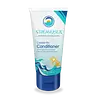What's inside
What's inside
 Key Ingredients
Key Ingredients

 Benefits
Benefits

 Concerns
Concerns

 Ingredients Side-by-side
Ingredients Side-by-side

Ketoconazole 1%
Benzyl Alcohol
PerfumingBHT
AntioxidantBlue 1 Lake
Cosmetic ColorantCitric Acid
BufferingCocamide Mea
EmulsifyingParfum
MaskingGlycol Distearate
EmollientHydrochloric Acid
BufferingHydroxypropyl Methylcellulose
Emulsion StabilisingPolyquaternium-7
Sodium Chloride
MaskingSodium Cocoyl Sarcosinate
CleansingSodium Hydroxide
BufferingSodium Laureth Sulfate
CleansingTetrasodium EDTA
Water
Skin ConditioningCamellia Sinensis Leaf Extract
AntimicrobialOcimum Basilicum Leaf
TonicAlaria Esculenta Extract
Skin ProtectingOlea Europaea Leaf
Skin ConditioningAloe Barbadensis Leaf Juice
Skin ConditioningCetearyl Alcohol
EmollientBehentrimonium Chloride
PreservativeGlycerin
HumectantDimethiconol Panthenol
Hydrogenated Vegetable Oil
EmollientCocodimonium Hydroxypropyl Hydrolyzed Keratin
Skin ConditioningCaprylic/Capric Triglyceride
MaskingCinnamidopropyltrimonium Chloride
Undaria Pinnatifida Vesicles
HumectantLactobacillus
Skin ConditioningHydrolyzed Keratin
HumectantSodium Levulinate
Skin ConditioningPotassium Sorbate
PreservativeTocopherol
AntioxidantPanthenol
Skin ConditioningParfum
MaskingCamellia Sinensis Leaf Extract, Ocimum Basilicum Leaf, Alaria Esculenta Extract, Olea Europaea Leaf, Aloe Barbadensis Leaf Juice, Cetearyl Alcohol, Behentrimonium Chloride, Glycerin, Dimethiconol Panthenol, Hydrogenated Vegetable Oil, Cocodimonium Hydroxypropyl Hydrolyzed Keratin, Caprylic/Capric Triglyceride, Cinnamidopropyltrimonium Chloride, Undaria Pinnatifida Vesicles, Lactobacillus, Hydrolyzed Keratin, Sodium Levulinate, Potassium Sorbate, Tocopherol, Panthenol, Parfum
 Reviews
Reviews

Ingredients Explained
These ingredients are found in both products.
Ingredients higher up in an ingredient list are typically present in a larger amount.
Parfum is a catch-all term for an ingredient or more that is used to give a scent to products.
Also called "fragrance", this ingredient can be a blend of hundreds of chemicals or plant oils. This means every product with "fragrance" or "parfum" in the ingredients list is a different mixture.
For instance, Habanolide is a proprietary trade name for a specific aroma chemical. When used as a fragrance ingredient in cosmetics, most aroma chemicals fall under the broad labeling category of “FRAGRANCE” or “PARFUM” according to EU and US regulations.
The term 'parfum' or 'fragrance' is not regulated in many countries. In many cases, it is up to the brand to define this term.
For instance, many brands choose to label themselves as "fragrance-free" because they are not using synthetic fragrances. However, their products may still contain ingredients such as essential oils that are considered a fragrance by INCI standards.
One example is Calendula flower extract. Calendula is an essential oil that still imparts a scent or 'fragrance'.
Depending on the blend, the ingredients in the mixture can cause allergies and sensitivities on the skin. Some ingredients that are known EU allergens include linalool and citronellol.
Parfum can also be used to mask or cover an unpleasant scent.
The bottom line is: not all fragrances/parfum/ingredients are created equally. If you are worried about fragrances, we recommend taking a closer look at an ingredient. And of course, we always recommend speaking with a professional.
Learn more about Parfum